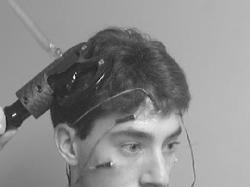Man 'roused from coma' by a magnetic field
- 15 October 2008
- NewScientist.com news service
- Linda Geddes

JOSH VILLA was 26 and driving home after a drink with a friend on 28 August 2005 when his car mounted the kerb and flipped over. Villa was thrown through the windscreen, suffered massive head injuries and fell into a coma.
Almost a year later, there was little sign of improvement. "He would open his eyes, but he was not responsive to any external stimuli in his environment," says Theresa Pape of the US Department of Veterans Affairs in Chicago, who helped treat him.
Usually there is little more that can be done for people in this condition. Villa was to be sent home to Rockford, Illinois, where his mother, Laurie McAndrews, had volunteered to care for him.But Pape had a different suggestion. She enrolled him in a six-week study in which an electromagnetic coil was held over the front of his head to stimulate the underlying brain tissue. Such transcranial magnetic stimulation (TMS) has been investigated as a way of treating migraine, stroke, Parkinson's disease and depression, with some promising results, but this is the first time it has been used as a potential therapy for someone in a coma-like state.
The rapidly changing magnetic fields that the coil creates can be used either to excite or inhibit brain cells - making it easier or harder for them to communicate with one another. In Villa's case, the coil was used to excite brain cells in the right prefrontal dorsolateral cortex. This area has strong connections to the brainstem, which sends out pulses to the rest of the brain that tell it to pay attention. "It's like an 'OK, I'm awake' pulse," says Pape.
At first, there was little change in Villa's condition, but after around 15 sessions something happened. "You started talking to him and he would turn his head and look at you," says McAndrews. "That was huge."
Villa started obeying one-step commands, such as following the movement of a thumb and speaking single words. "They were very slurred but they were there," says Pape, who presented her findings this month at an international meeting on brain stimulation at the University of Göttingen, Germany. "He'd say like 'erm', 'help', 'help me'."
After the 30 planned sessions the TMS was stopped. Without it, Villa became very tired and his condition declined a little, but he was still much better than before. Six weeks later he was given another 10 sessions, but there were no further improvements and he was sent home, where he remains today.
Villa is by no means cured. But he is easier to care for and can interact with visitors such as his girlfriend, who has stuck by him following the accident. "When you talk to him he will move his mouth to show he is listening," McAndrews says. "If I ask him, 'Do you love me?' he'll do two slow eye blinks, yes. Some people would say it's not much, but he's improving and that's the main thing."
”If I ask him, 'Do you love me?' he'll do two eye blinks. You might say it's not much, but he's improving and that's the main thing
John Whyte of the Moss Rehabilitation Research Institute in Philadelphia, Pennsylvania, cautions that as intriguing as Villa's case is, it alone does not show that TMS is a useful treatment. "Even after eight months, it is not uncommon for patients to transition from the vegetative to the minimally conscious state without any particular intervention," he points out. He says TMS merits further investigation, along with other experimental treatments such as drugs which have temporarily roused three men from a coma, and deep brain stimulation, an invasive technique that roused a man out of a minimally conscious state.
"This is the first and very interesting use of repetitive TMS in coma," says Steven Laureys of the Coma Research Group at the University of Liège in Belgium. Our understanding of disorders of consciousness is so limited that even a single study can provide new insights, he says.
Pape acknowledges that further studies are needed to demonstrate that TMS really is beneficial, though she is convinced that it helped Villa. He had only been given a 20 to 40 per cent chance of long-term recovery, and until he was given TMS his functioning had not improved since about four months after the accident. What's more, after the 15th TMS session, he improved incrementally with each session - further evidence that TMS was the cause.
Pape hopes to begin treating a second patient in a coma-like state later this year. This time she plans to adjust the number of pulses of TMS in each train, and to alter the gap between pulses to see if there is an optimum interval.
McAndrews is also in no doubt that her son's quality of life has improved as a result of TMS. "Before I felt like he was not responsive, that he was depressed almost. Now you move him around and he complains - he can show emotions on that level."
See "Editorial: improving the lot of coma patients"